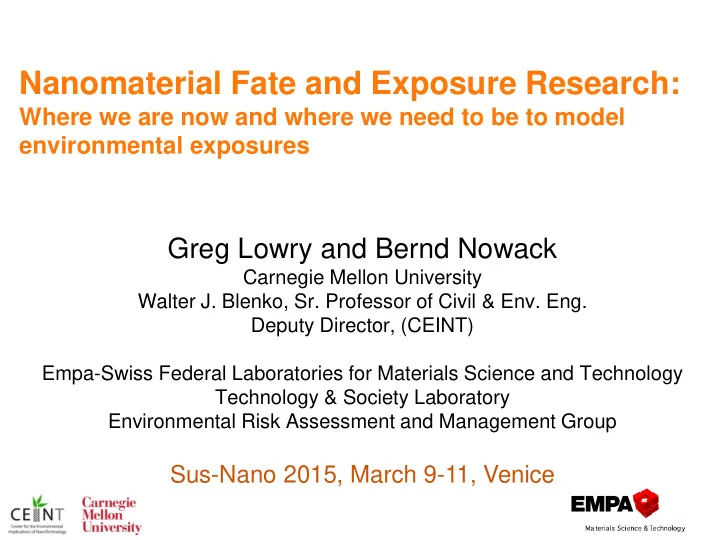

Nanomaterial Fate and Exposure Research: Where we are now and where we need to be to model environmental exposures Greg Lowry and Bernd Nowack Carnegie Mellon University Walter J. Blenko, Sr. Professor of Civil & Env. Eng. Deputy Director, (CEINT) Empa-Swiss Federal Laboratories for Materials Science and Technology Technology & Society Laboratory Environmental Risk Assessment and Management Group Sus-Nano 2015, March 9-11, Venice
Environmental Fate Modeling NM Sources/Inputs Environmental Processing Where are the NMs? What is their form? What are the NMs doing? Exposure Exposure Route 1 Exposure Route 3 Route 2 Effects of Interest Acute Toxicity Chronic/Multigenerational Effects Ecosystem Function/Services
In the Beginning…… Nanomaterial Nanomaterial System What is it? Properties Properties Descriptors Nanoparticle What can happen Impacts because of it?
exposure Material & Properties System What is it? Nanoparticle System Properties Properties Bio-Geo-Chemical Material and System Distribution in Transformations in the System the System Interactions Where does it go and what does it do? Exposure Potential risk Biouptake / System Transfer Material Impacts Bio-Transformation Bio-Distribution What can happen because of it? Cellular and Ecosystem Organismal Hazard Hazard hazard
Material and System Properties Product Properties Nanoparticle System Properties Milieu Release Amount Properties (solid matrix, Fraction LEVEL 1 suspension…) Shape Composition NOM/ Fluid Macromol Flow Coating Ionic Environmental Surfaces Composition Size Stressors (bacteria, Availability clay…) pH Light Processes Preceding Attachment ROS Biouptake LEVEL 2 Dissolution Collision Rate Aggregation Biodegradation Redox Settling Distribution in the Geochemical Bio-Geo-Chemical Deposition System Transport Speciation/ Transformations Transformations Exposure Potential Biouptake / System Transfer Processes Following Biouptake LEVEL 3 Biodistribution Biotransformation Nutrient Cycling Trophic Transfer Maternal Transfer Parameter or Process LEGEND Mechanism Community Cellular and Composition Example of Outcomes LEVEL 4 Ecosystem Mechanism Organismal Discovered Via Hazard Integrated Hazards Research
Key Questions to Address? What models, systems, and model frameworks do we need? What are the key parameters and inputs needed in those models? How do we measure those parameters for nanomaterials in complex systems? How can we validate our models?
Some Key Models are Required
What Model Parameters Best Describe Fate? Meade (ed.) USGS Circular 1133, 1995 Westerhoff and Nowack, 2013, Accounts in Chemical Research 46: 844-853.
Most Fate Work Can Inform Models, but cannot Parameterize the Models Ag Ag 2 S Coated NZVI Levard et al., ES&T 2011 45 (12), 5260. Ma et al., 2013 ES&T 47 (6), pp 2527 – 2534; Ma et al., 2014 ES Nano 1 347-357. 0 Log(N/N 0 ) -2 20% Fe0 RNIP Anaerobic -4 PSS Coated RNIP PA Coated RNIP NOM Coated RNIP DI 1% SDS SR water MRNIP2 -6 Hyung, et al. Environ. Sci. 0 10 20 30 40 50 60 Time (minutes) Technol . 2006 41(1) 179-184 Li et al., ES&T 44 (9) 3462-346
• • • • • • • • • “Functional Assay” Approach to Parameterize Models � Functional� Assay-Rooted� Approach� Nanoparticle Properties Social & System Engineered Properties Properties Engineering Models • Aggregation rate • Attachment efficiency Functional • Distribution coefficient Assays • Dissolution rate Exposure Hazard Risk RISK �
This becomes more important as nanomaterial complexity increases Saleh et al., 2015 ES Nano 2 11-18
Modeling environmental exposure Material-flow modeling Sources: Production, use Fate in technical systems: wastewater, solid waste, recycling Provides flows to the environment Environmental fate modeling Provides predicted environmental concentrations First tier: Simple box models Second tier: Mechanistic models
Information needs for release modeling
Production and use Sun et al., (2014) Environ. Pollut. 185: 69-76
Modeling flows to the environment air Production Products sewage treatment Release water Fate Nano- Particles sediment waste incineration soil landfill
Material-flow model for nano-TiO 2 in the EU Sun et al., (2014) Environ. Pollut. 185: 69-76
Environmental concentrations Sun et al., (2014) Environ. Pollut. 185: 69-76
Fate models for nanomaterials Meesters (2014) ES&T 48, 5726 Praetorius (2012) ES&T 46, 6705
Conclusions Life-cycle based material flow models are well established Able to provide flows to the environment and estimates of concentrations More production and use data needed Transformations during use and release needs to be included Next level of complexity involves dynamic processes First versions of environmental fate models available Rely on flow models for input Average region vs. spatially-resolved Heteroagglomeration as main unknown input Experimental data on heteroagglomeration needed Transformations only marginally covered
Recommend
More recommend